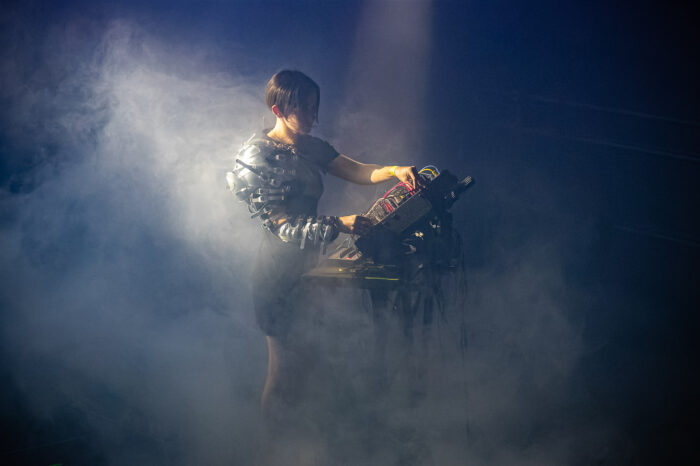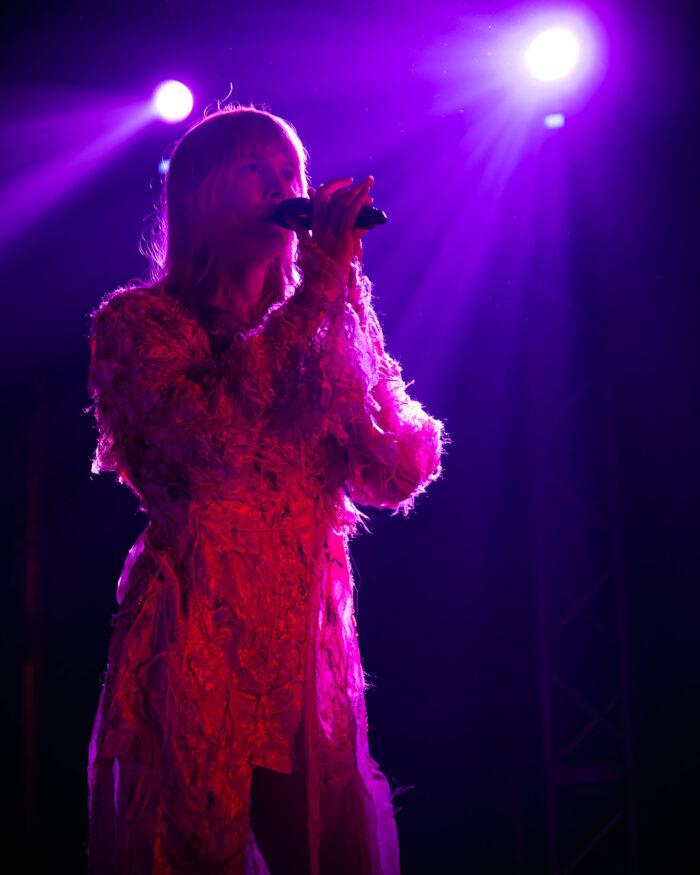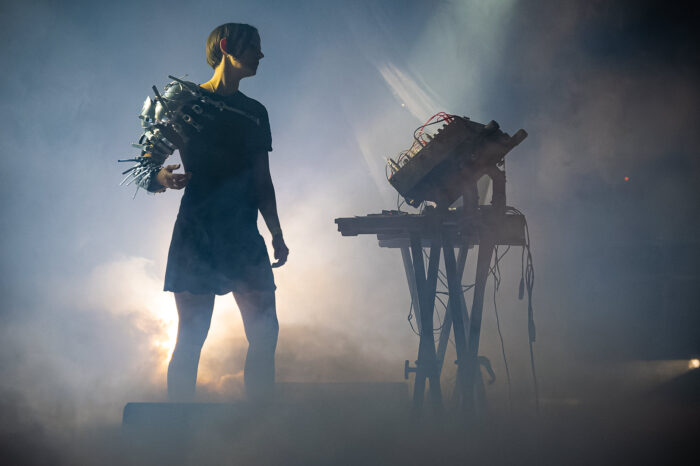Sonic Techno-Mysticism
Sonic configurations of human-machine relation and forms of non-religious mysticism: Caterina Barbieri and Lyra Pramuk’s sonic practices
The composers and performers Caterina Barbieri and Lyra Pramuk develop sonic practices that generate discourses related to the human-machine relation and forms of non-religious mysticism, according to processes of sonic configuration.
MACHINE
A crucial element for the practices of both Caterina Barbieri and Lyra Pramuk is the interaction with the machine, developed according to different terms from the traditional ones. Yet the connection between humans and machines in western modernity has generally been considered as a functional relation between a conscious rational subject and a tool that operates according to the intentions of the former, mainly for commercial, military, or industrial purposes. Even with the emergence of digital machines, able to elaborate complex information and, in some cases, make decisions according to artificial processes of reasoning, machines have maintained their status as passive components of the military-industrial complex. Yet, as its functioning evidently exceeds the constrained position which they have been assigned, opposing theories of how machines would operate outside the framework of western modern culture have appeared. Within this context, machines are occasionally identified either as the main threat to human life (singularity) or as the means that will allow humans to become immortal (transhumanism). However, in both cases, they are still subordinated to humans’ main fear (death) or desire (eternal life), therefore the traditional means-to-an-end logic is yet again repurposed. A radical new approach, beyond the dichotomy singularity-transhumanism, would then require a non-functional relation which takes into account the machine’s specific modes of operating.

With a post-humanist approach, the practices of Caterina Barbieri and Lyra Pramuk establish such connection, developing a pre-symbolic and non-discoursive relation with the machine, aiming at generating ecstatic states—as the title of Caterina Barbieri’s last album Exit Spirit suggests, and, even more explicitly, as her previous album Ecstatic Computation evokes—through the interaction between the human intentionality of the artist and the digital operativity of the machine. Interestingly, the seemingly unresolvable oxymoron of Ecstatic Computation opens up a new perspective on the human-machine relation. The friction created by the notion of ecstasy, identifying a condition in which one loses control over her self because of an intense emotion of mystical origin, associated to the notion of computation, referring to the process of reducing complex information into sequence of mathematical symbols, draws the attention on the deep common ground that connects the spiritual life of humans and their rational activity; it is a pre-symbolic and pre-individual dimension, where the two levels are yet to be distinguished. Notably, this indistinguishability can also be proved from the computational point of view. With his theory of incompleteness in mathematics, the mathematician Gregory Chaitin demonstrated that randomness, rather than finite sets of axioms, is at the core of mathematical procedures. So mathematics itself appears to be founded on a ground of indeterminacy that cannot be contained into fixed structures. Thus similarly to ecstatic experiences, which overcome the boundaries of the individual subject, mathematics appears to be based on an ecstatic sequencing of numbers, as they occur according to a logic beyond any predetermined mathematical axiomatics.

Combining the use of analogue and digital instruments, Caterina Barbieri explores the sonic possibilities of the machine through a recursive process in which simple sonic elements gradually constitute increasingly articulated sonic objects. In order for a recursive process to generate complexity, rather than just repeating itself, it is however necessary to include a rate of contingency and unpredictability within it. Her work is indeed the result of a negotiation of multiple agents: the human activity and intentionality, the unpredictability and aliveness of analog modular synthesisers, the generative possibilities offered by digital computation and, during her live performances, the surrounding environment. All these factors create the circular dynamic from which sound pieces emerge as organic combinations of multiple elements. In his book Recursivity and Contingency, the philosopher Yuk Hui highlights the crucial role played by contingency within recursive processes to generate complex and organic entities. “Recursion is the movement that tirelessly integrates contingency into its own functioning to realize its telos,” Yuk Hui argues. “In so doing, it generates an impenetrable complexity in the course of time. Organisms exhibit a complexity of relations between parts and whole inside the body and with its environment (e.g., structural coupling) in its functioning.”
The problem of combining contingency and rationalisation within electronic music composition is, according to the composer Iannis Xenakis, not just an aesthetic issue, but a question that is part of one of the fundamental dilemmas of western culture since its origins. In his volume Formalized Music, he claims that “there exists a historical parallel between European music and the successive attempts to explain the world by reason. […] It is only recently that knowledge has been able to penetrate chance and has discovered how to separate its degrees—in other words, to rationalize it progressively, without, however, succeeding in a definitive and total explanation of the problem of ‘pure chance’.” This integration of contingent and random elements within the process of composition is a distinctive aspect of Caterina Barbieri’s work.
A different kind of recursive logic is central to the practice of Lyra Pramuk, in which her voice operates as the only source of sonic data, digitally processed by a series of machines and software that alter, combine, and reconfigure her vocal inputs into sonic entities that grow and develop as intertwined streams of vocal threads. Through this fluid structuring of her compositions, in which multiple layers of vocality overlap and merge together with one another similarly to a sequence of ocean waves, Lyra Pramuk creates polyphonic pieces pervaded by a supernatural sense. As medieval polyphony, developed in the context of Christian devotion and religious architectures, in which the reverberations caused by vaults and aches were fundamental sonic elements of sacred music, Lyra Pramuk’s polyphony deploys machines to recreate these sonic-architectural elements. Yet arches and vaults are replaced by electronic and digital tools, which integrate the sacrality of polyphony with the electronic dimension, thus merging devotional vocal practice with new forms of post-religious rituals, such as techno and rave culture.
MYSTICISM
Mystical elements are present in the practices of Caterina Barbieri and Lyra Pramuk both as explicit references and a general undertone that infuses their sonic creations. It is a kind of mysticism, however, reframed and reconfigured according to new logic and intentions. Traditional mysticism has usually aimed to the rejoining of the self with the cosmos as the resolution of the problem of human suffering. Its fundamental idea is that by overcoming the self-cosmos division one also overcomes the corporeal, spiritual, and existential suffering that have resulted from it. This form of mysticism therefore implies the presence of a cosmic order, often arranged by a divine entity, which an individual intends to rejoin through an immediate experience that would allow her to dissolve her self into it. For mediaeval Christianity, mystical experience unfolds through bodily practices and, particularly, singing, because, as both bodily and linguistic activity, singing binds theology and ecstasy into a single performance. The 12th century mystic Hildegard of Bingen maintained that singing is a reflection of God’s creative power itself travelling through the world as a breath. Therefore, through singing, one could provide a conduit for the breath of God’s incarnate Word.

Although deprived of any religious significance, in Caterina Barbieri’s and Lyra Pramuk’s music, practices of vocality maintain their mystical tension toward an outside that shuffles the subjective structures of the self. However, while in Caterina Barbieri’s work, the voice appears only rarely as a subtle breath that almost imperceptibly emerges from the surface of the flow of her sound pieces, for Lyra Pramuk, the voice is the only sonic agent generating multiple vocal layers. Looping circularly, those layers of voice evoke a cosmic breathing and that divine breath mentioned by Hildegard of Bingen. Lacking any theological connotation and detached from specific verbal meanings, her vocal harmonies create expanded virtual dimensions yet to be actualized, thus maintaining an absolute openness toward infinite possible linguistic reconfigurations. Her use of voice is indeed not constrained by a determined symbolic code, but operates only according to a sonic logic, thus becoming a field of experimentation for new possible forms of vocal interaction. These experimentations with new configuration of vocality, therefore, do not occur through the imposition of codifications of vocal sounds, but according to an emergent logic. For Lyra Pramuk, as for Caterina Barbieri, zones of intensities are generated as fractals whose complexity is reached through a process of assembling of minimal acoustic units that progressively produce organic sonic entities. Within this scenario, not only linguistic communication becomes impossible, but any kind of linearity is dissolved into a spiral, including melodic lines, which are indeed only possible as “Broken Melodies,” as one of the tracks of Caterina Barbieri’s Exit Spirit is titled.
By correlating mediaeval devotional polyphonic music with techno and rave music, Lyra Pramuk puts in relation two music cultures developed outside the history of modern music, whose fundamental trait is the distinction between melodic themes and accompaniment. In his article on techno-raves, the British musicologist Philip Tagg highlights this fundamental difference between techno and modern music, arguing that “techno-rave puts an end to nearly four hundred years of the great European bourgeois individual in music.” He explained this historical shift caused by techno, referring to “the relationship between, on the one hand, the advent of the figure/ground dualism in European visual art, with its central perspective, and, on the other hand, that of the melody/accompaniment dualism in European music. These developments in European art prefigure and/or accompany the rise of the bourgeois notion of the individual.” Thus, borrowing terminologies from the visual art field, Tagg describes techno-raves in terms of the dissolution of the figure and emerging of the ground as a sole subject: “The Decline of Figure and the Rise of Ground,” as the subtitle of his essay eloquently reads. This process of dissolvement of the figure into the ground creates a link between mediaeval polyphonic music and techno, which Lyra Pramuk explores and develops in her practice. This combination of these two music cultures that in different ways challenge the unit of the individual subject, create a constellation of pre- and post-modern music stances generating yet another recursive loop in which polyphony and techno mutually give new significance to one another.
KNOT OF SPIRIT
The practices of Caterina Barbieri and Lyra Pramuk intersect and merge together in their collaborative piece Knot of Spirits. In this piece, Caterina Barbieri’s accelerating circular sequence of increasingly sharp sounds and Lyra Pramuk’s expanded vocal waves steadily advancing and overlapping one another generate a composite sonic unity. In this process, their two distinct techno-mystical stances are interwoven into a single entity. Their two sonic paths converge and tie together into a spiritual knot or “knot of spirit.”






